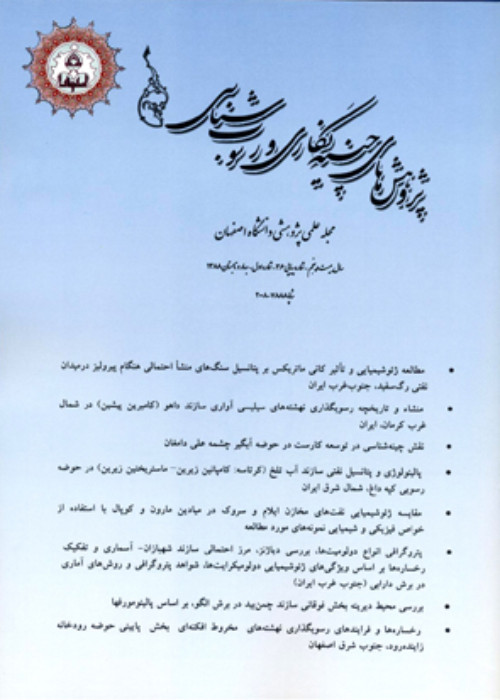Quantitative analysis of palaeoecological features and paleobiogeographic setting of brachiopod fauna in the Julfa Formation (Early Lopingian), northwest Iran
Author(s):
Article Type:
Research/Original Article (دارای رتبه معتبر)
Abstract:
Introduction
Lopingian succession in the vicinity of Julfa (East Azerbaijan Province, NW Iran) have been known for a long time among the most fossiliferous sections in the south of Paleotethys, especially those of the Ali Bashi Mountains (Stepanov et al 1969). They play a key role in the subdivision of the Late Permian sedimentary successions of the Tethyan Realm. The Wuchiapingian Julfa Formation was accumulated on a shelf environment with a gradual deepening upward trend into the Changhsingian Ali-Bashi Formation. Brachiopods are the most important macrofaunal content of the Julfa Formation while the Ali-Bashi Formation (Sensu Teichert et al 1973) comprises a considerably rich pelagic fauna consisting of conodonts and cephalopods, allowing for the separation of a number of biozones within this time unit. The Julfa Formation contains well diversification of Wuchiapingian brachiopods, grade into 4 biozone in both Main Valley section of the Ali Bashi Mountains and the Zal section (Ghaderi et al., 2014 a, b). The aim of this research is the study of species diversity and settling preferences of these marine invertebrate and their relations with the sedimentary environment. For these purpose, 528 in situ brachiopod specimens have been collected from the Main Valley section of the Ali-Bashi Mountains and the Zal section.
Material & Methods:
The brachiopods specimens have been collected in situ from the shale, marl and limestone beds of the Julfa and Ali Bashi formations. Also, the upper parts of the Khachik Formation in the Zal section have been yielded few brachiopods (only 2 species). The total number of brachiopods obtained from both the Main Valley and Zal sections are 528 specimens, of which 275 of them belong to the Main Valley and 253 of them belong to the Zal section. The Shannon Wiener index has been used to study the biodiversity and the relative richness of the brachiopod communities. The trend of their diversity changes has also been analysed during the stratigraphic column of the Julfa and Ali-Bashi formations. Interpretation of the brachiopods settling preferences have been done based on Angiolini and Carabelli (2010), analysis of biodiversity and shell size changes according to the method by Angiolini (2007) and recognition of paleobiogeographic position is mainly based on Shen and Shi (2000) and Shen et al (2000).
Discussion of Results & Conclusion:
Paleoecological studies on 528 in situ specimens of Lopingian brachiopods from the Julfa area in the northwest of Iran provided an analysis of their distribution pattern on the Late Permian ecosystems. The present brachiopod fauna are mainly articulate specimens indicating that they are in life assemblages, with no or minor transport. Brachiopods have been grouped into five categories according to their settling preferences:1- Concavo-convex with stout halteroid spines (i.e. Araxilevis);2- Concavo-convex spiny semi-infaunal (i.e. Cathaysia, Spinomarginifera, Haydenella, Tschernyschewia, and Sarytchevinella);
3- Pediculate taxa (i.e. Transcaucasathyris, Araxathyris, Permophrycodothyris);
4- Pediculate stabilized by penetration of the elongate umbonal region (i.e. Meekella,
Orthothetina, Perigeyerella);
5- Cemented taxa (Lyttoniidina).
Evaluation of the brachiopod’s settling preferences demonstrate the dominance of spinoid taxa which authenticate the firmground substrates of low energy environments in the lower parts of the Lower Julfa beds. In contrast, the upper part of these Beds is the place of development of pediculate taxa, belong to higher energy conditions. The abundance and diversity of the brachiopods decrease in accordance with the facies changes from bioclastic rudstone/packston of the upper part of the Lower Julfa Beds into the lime mudstone/wackstone of Upper Julfa Beds and Ali-Bashi Formation (Leda et al 2014), where dominance of pelagic ammonoids and conodonts confirm the outer shelf environment. This suggests a deepening upward trend from rich nutrient settings below fair weather wave base into the deep water meagre nutrient substrates below the storm weather wave base in agreement with lithological and sedimentological data.
Measurement of the Shannon-Wiener biodiversity index for the brachiopod contents and its inspection alongside the stratigraphic log indicates unfavorable environmental conditions for these animals during late Lopingian, while these conditions have deteriorated toward end Permian. This is in accordance with an increase in the mortality rate of brachiopods during the succession which is obtained from the analysis of the shell size.
Comparison of the Julfa Formation brachiopods with the paleobiogeographic provinces of the Lopingian epoch (for example: Shi and Grunt 2000; Shen and Shi 2000) reveals the faunal affinity with the Cathaysian to Western Tethyan provinces. Contrary to previous beliefs that consider the tendency of the fauna from Cathaysian to Western Tethyan Province since the Changhsingian age, abundant presence of some species such as Tschernyschewia typica in the lower part of the Lower Wuchiapingian Julfa Beds suggest this inclination begins from the Wuchiapingian age.
Keywords:
Language:
Persian
Published:
Stratigraphy and Sedimentology Researches, Volume:34 Issue: 2, 2018
Pages:
95 to 119
magiran.com/p1916939
دانلود و مطالعه متن این مقاله با یکی از روشهای زیر امکان پذیر است:
اشتراک شخصی
با عضویت و پرداخت آنلاین حق اشتراک یکساله به مبلغ 1,390,000ريال میتوانید 70 عنوان مطلب دانلود کنید!
اشتراک سازمانی
به کتابخانه دانشگاه یا محل کار خود پیشنهاد کنید تا اشتراک سازمانی این پایگاه را برای دسترسی نامحدود همه کاربران به متن مطالب تهیه نمایند!
توجه!
- حق عضویت دریافتی صرف حمایت از نشریات عضو و نگهداری، تکمیل و توسعه مگیران میشود.
- پرداخت حق اشتراک و دانلود مقالات اجازه بازنشر آن در سایر رسانههای چاپی و دیجیتال را به کاربر نمیدهد.
In order to view content subscription is required
Personal subscription
Subscribe magiran.com for 70 € euros via PayPal and download 70 articles during a year.
Organization subscription
Please contact us to subscribe your university or library for unlimited access!



